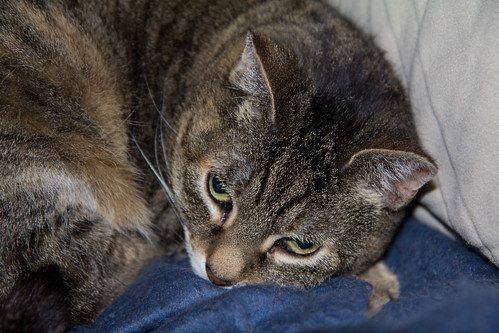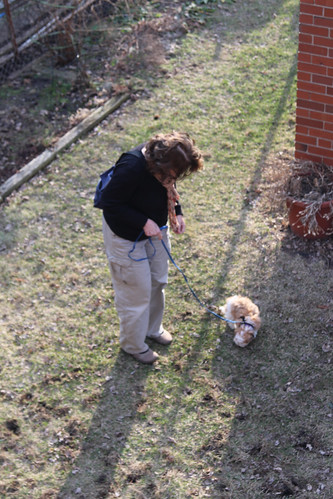
Two weeks from today, Pip will arrive at our house. She'll be instantly beloved by the people here: me, my husband, our 29-year-old son who is back at home taking some classes at the local university while working on an internship as a computer programmer, and my 96-year-old mother-in-law. We'll have to be careful about Pip being underfoot when my mother-in-law is walking about. She is pretty steady, but needs a cane to walk from room to room, and it'll be important to keep Pip from getting underfoot. So I've ordered a nice little soft-sided crate to keep in our TV room when Pip's in there with me. (Our evening ritual since my MIL moved in with us involves me watching whatever TV programs she wants to see every evening.) I'll only zip Pip in the crate when I'm helping my MIL do her physical therapy exercises each day and when we're preparing, eating, and cleaning up after dinner--the rest of the time I'll leave it open for Pip to go in and out as she pleases, calling her to me when my MIL gets up to do anything.
I usually spend most of the day up in my home office. I'm a writer, and when I'm working, Pip will spend that time with me. My office is a mess right now (I'm working on two books, and any time I'm in the middle of a project, entropy takes over), but I'm working at getting it tidied up and puppy-proofed. I'll have one of her dog beds in there, and also a little soft dog house she can go in and out of. Until I'm sure everything is puppy-proofed, I'll have her X-pen in there for when I have to leave the room if I can't bring her along.
My licensed education bird, an Eastern Screech-Owl named Archimedes, lives up in my home office in a huge flight cage, and I'm sure Pip will be fascinated by him. There's no risk of the two getting too close—the cage is sturdy. Archimedes is 16 now—I got him in 2000, when he was 1 year old, and until my little dog Photon died last year, he spent most of his days with a little dog in the room and didn't mind at all. Our cats are banished from that room (Archimedes is petrified of Kasey, whose goal in life has been to kill him).
At bedtime, I'll bring the small crate to our room, next to our bed for sleeping. That'll keep her confined if she does have to ::ahem:: use the facilities and I don't wake up. I'll be working with her on housebreaking from the start, but until she's reliable, I will keep pee pads in the crate with her. Our bedroom doesn't have a lot of stuff for her to get into, so when she's mastered housebreaking and after I've made sure there are no hidden dangers in there, that's the room I'll leave her in when I'm away on errands, unless my son is home and wants her in his room. For the next 4 months or so, I'll be going to cardiac rehab three times a week, and right now I have more doctor appointments than normal. I used to bring Photon along on little jaunts like that except when it was too cold or warm to leave her in the car. I'll do that with Pip when she feels safe and happy waiting for me in the car, too. Meanwhile, our room will serve as her quiet place/kennel.

Our Miss Kitty is 18 years old now. She doesn't approve of dogs, but doesn't mind them after she gets to know them, though she hides out and only slowly and cautiously approaches at first. It may take a day or two before she starts spending time in the TV room with us at night again, but that'll be fine.

Kasey, our 9-year-old cat, started out as a feral cat from one of those horrible TNR programs in Ohio. She was killing birds in my daughter Katie's yard until I enticed her into my car and drove 800 miles home with her. My car is the first place she ate expensive canned cat food, and she instantly felt at home in it, so she went back and forth with me when I was working at the Cornell Lab of Ornithology in Ithaca, along with Photon. The two of them loved each other from the start, and I'm certain Kasey will end up loving Pip, too, though it may take some time. Kasey has already fallen in love with the little dog house I bought for Pip. I'm probably going to keep that in my office at first, which may make Kasey feel deprived, but as Pip gets housebroken and learns the family routines and doesn't need to be crated downstairs anymore, I may bring it to the TV room for the two of them to share.

The very first week I have Pip, I'll be doing an evening program down in the Twin Cities, and I'll be spending that night with my friend Jane. That'll be Pip's and my first jaunt out of town together alone. There's one convenient rest stop along the way, and another place to stop for a little break and snack, too, so we won't have to drive the whole way without a break. If it's cold outside, I'll leave Pip at Jane's during my talk. If it's more pleasant, the two will come along so Jane can see my program, and we'll leave Pip in the car, in a car kennel, with Jane or me checking on her every 20 minutes or so. I'm hoping she enjoys car rides and learns as quickly as Photon did that I always come back and the car is a safe refuge, so these trips will be entirely fun.
I know I'm very optimistic, but that optimism is steeped in experience. I learned with our two previous family dogs, our golden retriever Bunter (1983-1997) and my bichon frise Photon (1998-2014), that when you expect a dog to behave, and patiently train her to do what you expect, she really does learn to accommodate your needs even as you learn to accommodate her unique personality and needs. It's always complicated introducing a new family member, and puppies are so inquisitive and intent on grabbing for all the gusto they can get out of life that it takes time and patience to channel their energies into acceptable outlets, especially when a fragile 96-year-old is part of the household. But the best thing about puppies is that even as I went through the worst parts of that long learning stage, they were so adorable that I never lost my patience or my optimism that it was all going to work out. And so, of course, it did.























 Julie wrote yesterday (Wednesday) that she:
Julie wrote yesterday (Wednesday) that she:
